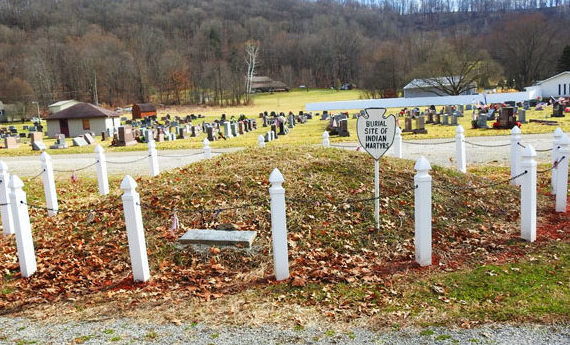EARL’S NOTE: One of the darkest days in American history was March 8, 1782. On that date, 96 innocent Christian men, women, and children at Gnadenhutten in Ohio were brutally executed by members of the Pennsylvania militia under the orders of Lieutenant Colonel David Williamson. This is a somewhat detailed version of the story of that massacre and the events leading up to it.
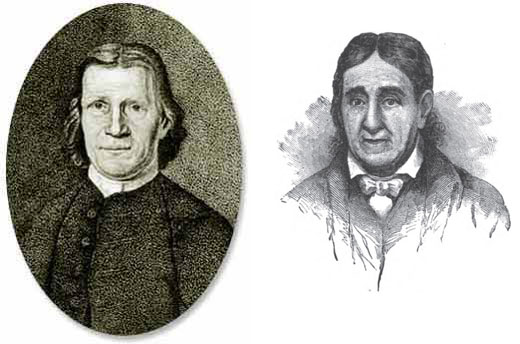
The story begins with the arrival of David Zeisberger in the vicinity of Bethlehem, Pa., around the late 1760s. Zeisberger was born in Moravia around 1721. He was a member of the Church of the Unity of the United Brethren which was usually simply referred to as the Church of the United Brethern. When he arrived in central Pennsylvania, he began ministering to the Lenape Delaware Indians in that region. His flock quickly grew and around 1762, an English missionary named John Heckewelder joined Zeisberger in his mission work with the Indians. However, tensions developed between the Christian Indians and the other inhabitants of the region. In 1772, Zeisberger, Heckewelder and 200 or so of the Christian Indians moved into the Ohio country to escape the increasing persecution by the white settlers and the non-Christian Indians. They built the towns of Gnadenhutten and Schoenbrunn on the Tuscarawas River. As unrest between the British and the Americans rose in the region, Chief Killbuck of the Delaware Turtle Clan suggested to the missionaries that they and their 300 or so mostly Delaware Christian Indian followers would be safer if they moved down to the main Delaware town of Coshocton where he could protect them. In 1776, Zeisberger, Heckewelder and eight Christian Indian families moved to a place on the Muskingum River less than a mile south of Coshocton where they established a new town that they called Licteneau.

By the spring of 1780, Heckewelder and Zeisberger decided that they would be better off back at their old towns on the upper Tuscarawas River, so they and most of their Christian followers left Lichtenau and returned to their old homes in Schoenbrunn and Gnadenhutten. However, Heckewelder and several of the Christian Indian families stopped about six miles south of Gnadenhutten. On April 6, 1780, they established a new town at that location that they called Salem. By 1780, over 400 Christian Indians were living in the area around the three towns and 10 white missionaries and teachers were living and working with them. On July 4, 1780, John Heckewelder married Sara Ohneberg at Salem with the Rev. Adam Grube presiding. Their daughter was born the following year.
When the Revolutionary War broke out, many of the Ohio Indian tribes chose to support the British side. However, most of the Delawares and the Moravian Christian Indians chose to remain neutral although Zeisberger and Heckewelder kept American commanders at Fort Pitt informed about some of the Indian activities in Ohio. The texts of some of letters between Heckewelder and Zeisberger to Generals Hand and Broadhead at Fort Pitt are in the Draper Manuscript Collection held by the Wisconsin State Historical Society. During the summer of 1777, Zeisberger learned that the Indians were planning an attack on Fort Henry. Starting in the middle of June 1777, Zeisberger sent a series of letters to General Hand at Fort Pitt notifying him of the impending attack. Hand responded by calling up five militia units to reinforce the fort and then sending Major Andrew Swearingen downriver from Holliday’s Fort with provisions for the enlarged garrison. The attack on Fort Henry came on Sept. 1, 1777.

In the spring of 1778, Simon Girty and several others left the service of the Americans at Fort Pitt and traveled to Fort Detroit to work for the British side. Girty suspected the spying activities of the two missionaries, and he lobbied for the British to destroy the Moravian Indian towns and remove the missionaries. He thought that the missionaries should be hanged for treason. Some of the Indians supported Girty’s desire to remove the Moravian Indians and the missionaries from the towns on the Tuscarawas River. However, British authorities at Fort Detroit continued to issue orders that the Christian Indians were not to be harmed. By the summer of 1781, chief Half King (Pomocon) of the Wyandots had grown impatient with the lack of action by the British in regard to the Moravian missionaries. He sent a letter to the commandant at Fort Detroit, Major Arent Schuyler DePeyster, demanding that the British take action or else “I will do so.” (Implying that he would kill the missionaries.)
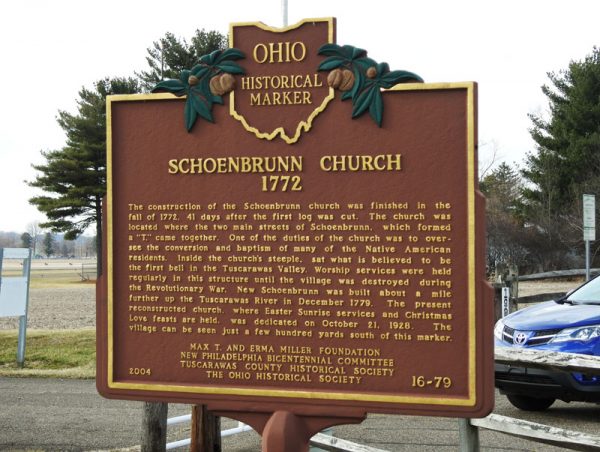
In late August of 1781 and in response to Half King’s threat, Major DePeyster sent Captain Matthew Elliott, along with a group of soldiers, to relocate the Christian Indians to an area on the Sandusky River near the Wyandot Village known as “Half King’s Town.” Half King and around 200 Wyandot and Delaware Indians accompanied Elliott’s men to the Christian Indian towns on the Tuscarawas. Heckewelder’s diary describes Simon Girty jumping up onto a chair and reading the letter from DePeyster informing the missionaries that they were to move to the Sandusky River region and stating that Half King was authorized to use force if they refused. However, Girty was illiterate and the letter was more likely read by either Elliott or Half King. At the time, a total of 10 white missionaries and teachers were living and working with the Moravian Christian Indians. DePeyster’s instructions were that the missionaries were to be treated with respect and that they were not to be mistreated in any way. However, Half King’s warriors ignored those instructions. They stripped the missionaries and pillaged their homes. Heckewelder described the Indians running around wearing the clothes that they had stolen from the homes of the missionaries. Some of the Christian Indian women prevailed upon Half King to allow them to give the missionaries something to cover their nakedness. Half king allowed them to give the missionaries some ragged dresses to wear. It is worthwhile to note that the Delawares apparently did not participate in any of the violence against the missionaries. Although the Wyandots plundered the missionaries, they permitted the Christian Indians to take some of their livestock and other belongings as they traveled by water and land to Coshocton at the forks of the Muskingum. From there, they followed the Walhonding River northwest and then went overland until they reached the Sandusky River several miles south of Half King’s Wyandot town. There, Half King and his warriors abandoned them telling them that they were free to build new homes anywhere in that region. Since the October winds were already blowing, they immediately set to the task of building cabins for winter shelter. Following the tradition of the Delawares, the women went out every day to dig wild potatoes for food. Because of the scarcity of suitable grazing land, the milk cows soon dried up, so babies and children went hungry. (Earl’s note: The wild potatoes eaten by the Delawares were actually wild sweet potatoes that we would recognize as morning glory plants.)
In late February, Girty arrived from Fort Detroit with orders to bring Zeisberger and Heckewelder to the fort to stand trial for treason. Because Girty was joining the Wyandots for an excursion against the Virginians, he assigned a Frenchman named Mr. Lavallie to take the missionaries to Fort Detroit. Girty instructed Lavallie to “drive them like cattle.” As Lavallie and the missionaries proceeded downriver on the trail along the Sandusky, he observed that Zeisberger had some difficulty walking due to his rheumatism. Lavellie gave Zeisberger his own horse while he walked instead. When they arrived at the lower Sandusky near the lake, a gentleman named Mr. Robbins offered the missionaries the hospitality of his home. Lavallie sent a letter to Fort Detroit asking for a boat to transport the missionaries to the fort from the mouth of the Sandusky River. After they had been at the home of Mr. Robbins for some weeks, a boat from Fort Detroit arrived to transport them to the fort. A company of British Rangers arrived on the boat with orders from Commandant DePeyster. DePeyster’s orders instructed Lavallie and the rangers to bring the missionaries to Fort Detroit. The letter stipulated that the missionaries were not to be harmed. The same day that the boat arrived with DePeyster’s orders, Girty also arrived in the area. When he learned that Lavellie had ignored his instructions to drive the missionaries overland like cattle to Fort Detroit, he was extremely angry. Heckewelder’s diary describes Girty threatening the missionaries with his tomahawk and then spending the night in a drunken rage. While they waited for the weather over the lake to calm down so that they could depart for Detroit, the missionaries received word of the killing of their Christian Indian brothers and sisters at Gnadenhutten.
Upon their arrival at Fort Detroit, Commandant DePeyster forced the two poorly clad missionaries to stand outside in the cold for several hours before he ordered them into his presence to face charges for treason. Some of the Indian leaders were also in the room. When DePeyster asked Chief Pipe for his testimony about the spying charges against the missionaries, Pipe spoke in defense of the missionaries. DePeyster declared that the missionaries were cleared of the charge of treason. He then ordered that they be fed and clothed and supplied them with some provisions to take back to their families on the Sandusky.
The winter of 1781-82 was very harsh, and the relocated Christian Indians had not been able to harvest their crops when they were forced from their homes, so they were suffering from starvation. The frozen ground prevented the women from digging wild potatoes, and the snow covered the grass causing most of their livestock to die from starvation. By February, the Christian Indians and missionaries were surviving by eating the decaying flesh of their dead cattle. When the weather broke at the end of February, about 150 of the Christian Indians obtained permission from Half King to return to their old homes on the Tuscarawas to harvest corn to bring back to their families at the Sandusky.
The unusually warm late February weather also led to an early rash of Indian Raids from the Ohio country into Virginia and Pennsylvania. On Feb. 8, a small raiding party killed John Fink in Pennsylvania not far from Buchanan’s Fort, on the upper Monongahela. A couple of days later, a small raiding party took a young man named John Carpenter captive from near Buffalo creek in Northwestern Virginia. (Now Brooke County, W.Va.) Some of the Indians who took Carpenter prisoner spoke Dutch and told Carpenter that they were Moravian. The raiding party crossed the icy waters of the Ohio River and then bedded down for the night putting the horses out to graze. The next morning, the Indians put John to work helping to round up the horses, and he was able to escape and make his way to Fort Pitt where he reported that his home had been raided by some of the Moravian Indians.
On Feb. 15, a raiding party struck the home of Robert Wallace on Raccoon Creek, several miles west of Pittsburgh. At the time of the raid, Robert was away from home having left early that morning to take corn to a mill which was several miles away. When he returned home that evening, he found his house in shambles. His livestock had been shot dead and the Indians had pillaged whatever they could carry off with them. Mrs. Wallace, along with the couple’s 10-year-old son, 2-and-a-half-year-old son, Robert, and infant daughter, had been taken captive by the Indians. Wallace rode to the homes of several of his nearest neighbors, and they headed out in pursuit of the Indians at first light the next morning. Unfortunately several inches of snow had fallen during the night, so they soon lost the trail.
As the raiding party traveled west, they made slow progress because of Mrs. Wallace and the baby. They had crossed the Ohio River and had gone only a short distance into Ohio when they did something that certainly impacted the later events. Because they were slowing the raiding party down, the Indians tomahawked Mrs. Wallace and the baby. Just beyond a bend in the trail, they cut off and sharpened two small saplings and impaled the naked bodies of Mrs. Wallace and the baby on them posing the bodies to make them appear to be looking down the trail toward the direction from which anyone in pursuit would be coming. The Indians took Wallace’s two sons with them. The 10-year-old year died in captivity from disease and malnutrition a year or so later. The younger son, Robert Wallace, survived and was adopted into an Indian family. When he was around 10 years old, he was returned to the white community, but had forgotten the English language.
Back at Fort Pitt, the Americans had learned that the Indian raiding parties were using the abandoned buildings at Salem, Gnadenhutten and Schoenbrunn as stopover points during their travels to and from the Indian villages in Ohio as they were conducting their raids in Pennsylvania and northern Virginia. In late February or early March of 1782, General Gibson at Fort Pitt organized a force of 160 Pennsylvania militiamen under the command of Lieutenant Colonel David Williamson to go into the Ohio country to burn the three abandoned towns. After failing to find the trail of the raiding party that had taken his family, Robert Wallace rode to Fort Pitt where he arrived just as the Williamson’s expedition was leaving for the Ohio Country. So he joined the expedition. When the militiamen rounded a curve in the trail in Ohio a few days later, they were greeted by the gruesome sight of the impaled bodies of Mrs. Wallace and the baby. To say that the militiamen were enraged with hatred for Indians would be an understatement.
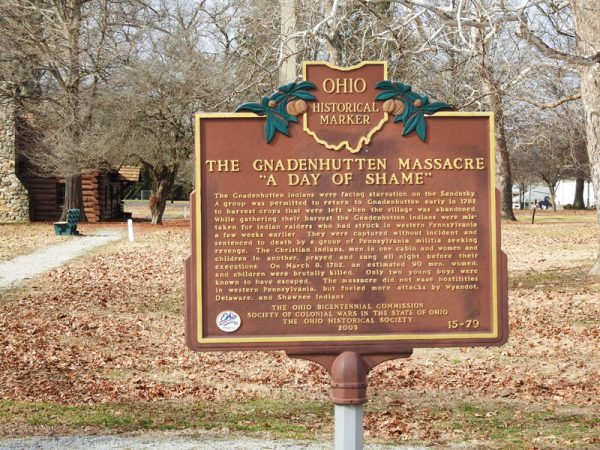
The next day, the army arrived in the vicinity of Gnadenhutten. After crossing a swollen stream, the militia encountered a man named Joseph Shebosh who was half Indian and half white. As Shebosh begged for his life, a militiaman named Charles Bilderback killed him with a tomahawk and scalped him. Colonel Williamson and his men were expecting the Moravian towns to be vacant, so they were surprised to discover a large number of Indians out working in the fields. Williamson sent detachments of militiamen to Schoenbrunn and Salem to bring back any Indians who were there. The Indians at Schoenbrunn had learned of the presence of the militiamen and fled before the detachment of militia arrived. However, the detachment that went to Salem returned to Gnadenhutten with several Indians families who were there. As they returned to the Gnadenhutten, the militiamen demanded that the Indians give up their arms to prevent any hostile actions against the militia. The peaceful Moravians complied with that request. Several of the militiamen spotted things in the town that they thought the Indians could have taken from some of their neighbors and family members who had been killed during Indian raids. Because of that, Colonel Williamson decided that the militia would take all of the Indians back to Fort Pitt to face trial for participating in the raids. They confined the Indians to two of the cabins with the men in one and the women and children in another. Then, Robert Wallace noticed that a teenaged Indian girl was wearing the dress that his wife had been wearing on the morning that she was captured by the Indians. He knew that it was Mrs. Wallace’s dress because he had watched his wife make the dress with her own hands. Some accounts say that the dress was still stained with the blood of Mrs. Wallace, but that is unknown. Although the girl claimed that a visiting Indian had given it to her in gratitude for some food that she had given to him, the enraged militiamen did not believe her.
The militiamen took a vote and all but 18 of the 260 men voted to execute all of the Indians for the murders of Mrs. Wallace and her baby. They informed the Indians of the decision and then allowed them to gather in the meetinghouse to pray. For most of the night, the Indians sang hymns and prayed. Some of the 18 men who voted against putting the Indians to death declared that they would have no part in the killings and were going to head back to Pennsylvania. So that they would not be considered deserters, Williamson gave them permission to leave provided that they would make their camp 10 or 12 miles away and then rejoin the army as it returned to the fort. Some historians have indicated that Williamson was not in favor of executing the Indians, but had no choice when all but 18 of the men voted to do so. It is worthwhile to note that many of militiamen had also participated in the Squaw Campaign and in the Coshocton Massacre.
Early on the morning of March 8, 1782, the militiamen brought the Indians into two of the cabins to be executed. The men were taken into one cabin and the women and children were taken into the other cabin. Nathan Rollins brought over a large wooden mallet that he had found at the cooper’s shop. Rollins was eager for revenge because his father and uncle had been killed by Indian raiding parties. When the militiamen came into the chapel to take the Indians to their deaths, an old man, who had taken the Christian name of Abraham and was one of the spiritual leaders of the congregation volunteered to go first. Abraham had long gray hair which some of the militiamen wanted as a trophy. The Indians were taken into the slaughterhouses two at a time. Rollins swung the heavy hammer striking the victims on the head stunning them. Then, another militiaman slit their throats. This was exactly the same procedure that was used for dispatching livestock at the slaughterhouses at the time. After they scalped the victims, the militiamen dragged them into some of the nearby cabins to be burned. Rollins swung the cooper’s mallet 14 times before declaring that his arm had given out. Then, he sat down and sobbed because his revengeful killing spree had not diminished his grief for his father and uncle.
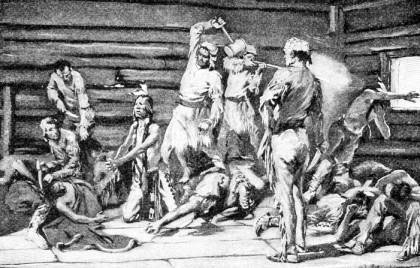
Two young boys were able to slip through a trap door in the floor and hide in the root cellar under one of the cabins. It ended up being the cabin where the women and children were being killed. When darkness fell, the militia set fire to the cabin, so the boys attempted to crawl out through a small opening in the foundation. The smaller boy went first and was able to escape and run to safety in the nearby woods. The older boy was unable to get through the opening and perished in the fire. The boy who survived in that root cellar described the blood streaming down through the floorboards as the women and children were being slaughtered. The only other survivor was a boy named Thomas who had been bludgeoned and scalped and tossed onto a pile of bodies in one of the cabins. When he came to, he noticed a friend named Abel who had also survived and was attempting to sit up when the militiamen brought another body into the cabin. One of the militiamen immediately killed Abel with his tomahawk, so Thomas pretended to be dead and lay perfectly still until the men left. Then, he got to his feet, climbed over the bodies and slipped out the door. Thomas and the boy who had escaped from the root cellar were both found by a group of Indians who were fleeing Schoenbrunn and heading toward the Sandusky. Thomas survived in spite of being scalped.
On March 8, 1782, those Pennsylvania militiamen murdered 96 innocent Christian men, women, and children. That number included 28 men, 29 women and 39 children. In his diary, John Heckewelder wrote, “The loving children who had so harmoniously raised their voices in the church, at school and in the parents’ houses in singing praises to the Savior. Their tender years, innocent countenances and tears made no impression on these white Christians. The children, together with 12 babes at the breast, were all butchered with the rest.”
After looting the homes, the militiamen burned the towns including the cabins containing the bodies. That killing field remained unvisited and untouched for 17 years. In 1799, 77 year-old David Zeisberger along with some friends and Christian Indian companions visited the site. They searched through the remains of the cabins where the bodies were burned and throughout the nearby grounds and collected the skeletal remains of as many of the victims as they could find and then buried them in a mass grave. A small mound at the site identifies that mass grave.

Geo-History Information
Lichtenau Historical Marker
Coordinates: N 40° 14′ 46.69″, W 81° 52′ 14.54″
The marker is located on the southeast corner of a busy intersection. If you decide to pay a visit and want to stop for a photograph, turn east onto Clow Lane and park at the apartment building a few hundred feet from the intersection
Salem Mission Historical Marker
Coordinates: N 40° 18′ 24.21″, W 81° 32′ 14.54″
This is on Rte. 36 out in the country. If you visit in person, you will find a nice turnout where you can stop for a photograph
Schoenbrunn Historical Marker
Coordinates: N 40° 28′ 01.98″, W 81° 24′ 48.05″
The marker is located at the entrance to the Schoenbrunn Village Historic site. If you plan to visit the site in person, you will want to do so in the summer because the historic site is not open during the winter months.
Gnadenhutten Historical Marker and Site
Coordinates: N 40° 28′ 01.98″, W 81° 24′ 48.05″
The marker is located near the burial mound at the site of the Gnadenhutten massacre. The marker is not visible from a Google Earth street view, although the road bordering the historic site has been imaged. Although the site is open year round, the visitor center is only open during the summer months.
For my history buff friends: Here are some of the sources of information for this story.
The Gnaddenhutten Massacre
Earl Nicodemus History Web Site
Url: https://tinyurl.com/nicodemushistory
Life of John Heckewelder
by Rondthaler, Edward & Coates, Benjamin Horner,
Publication date 1847
Publisher Philadelphia, T. Ward
A narrative of the mission of the United Brethren among the Delaware and Mohegan Indians
by Heckewelder, John Gottlieb
Publication date 1820
Publisher Philadelphia: McCarty & Davis
History of the mission of the United Brethren among the Indians in North America
by Loskiel, George Henry, Christian Ignatius, & Adams, John
Publication date 1794
Publisher The Brethren’s Society for the Furtherance of the Gospel
Diary of David Zeisberger
by David Zeisberger
Publication date 1885
Publisher R. Clarke & Co
The Life and Times of David Zeisberger: The Western Pioneer and Apostle
by Edmund De Schweinitz, Edmund Alexander De Schweinitz
Publication date 1871
Publisher J.B. Lippincott
A true history of the massacre of ninety-six Christian Indians, at Gnadenhuetten, Ohio, March 8th, 1782
by Gnadenhutten Monument Society
Publication date 1870
Topics Gnadenhutten Massacre, Gnadenhutten, Ohio, 1782, Moravian Indians
Publisher New Philadelphia, Ohio, Printed at the Ohio Democrat Office
All of the photographs in this story were taken by Earl Nicodemus. The drawing of the massacre was published during the 1800’s and is in the public domain.


